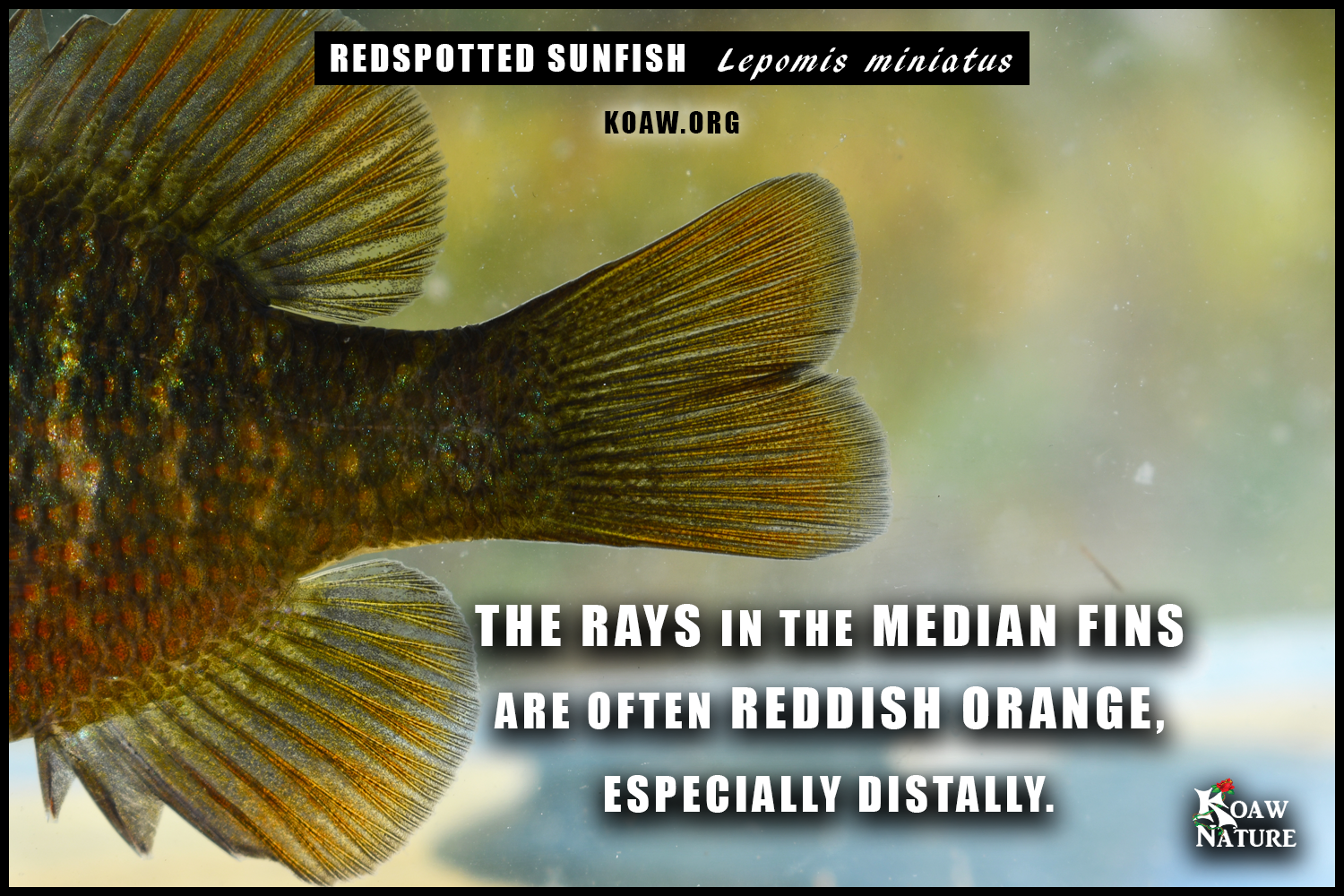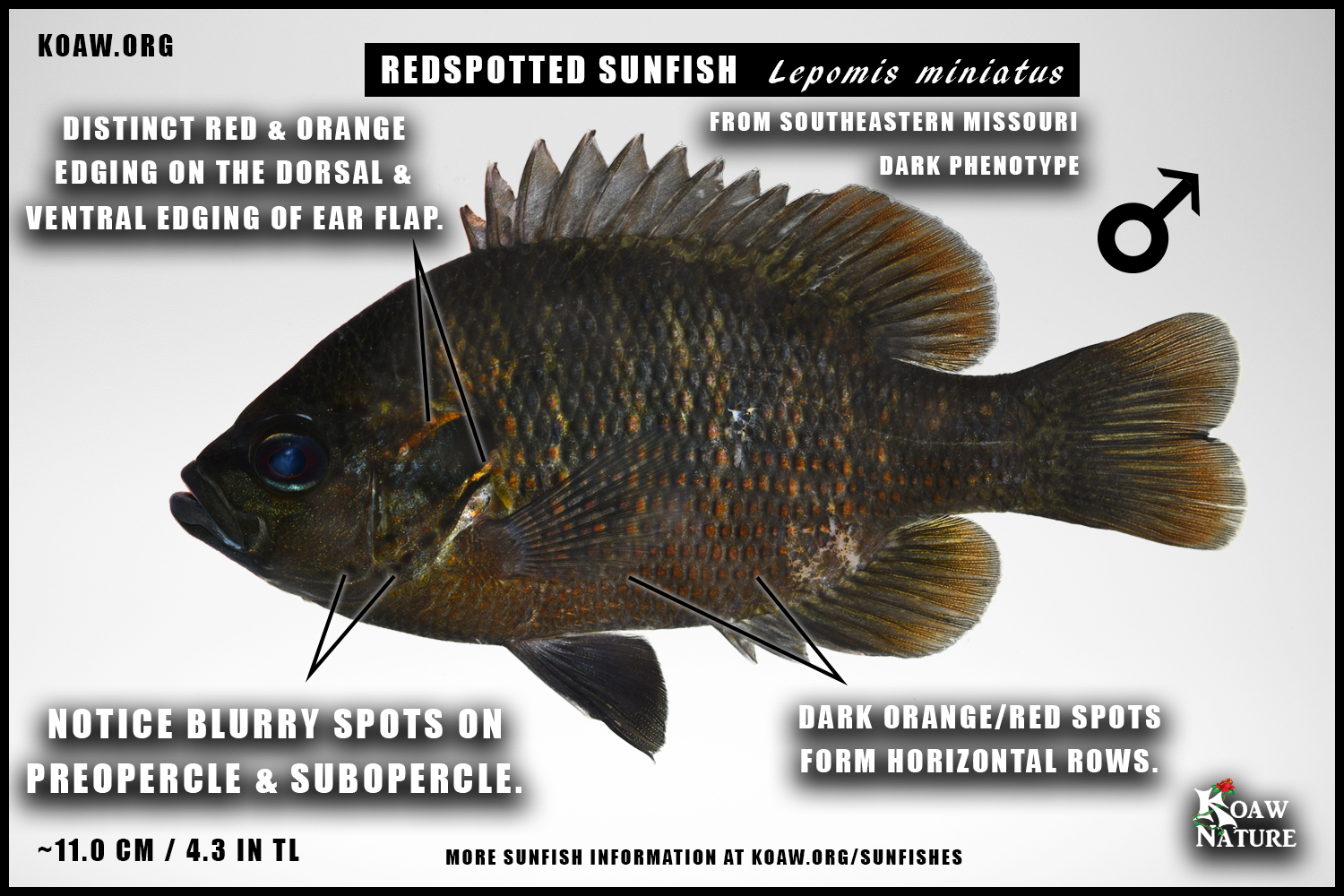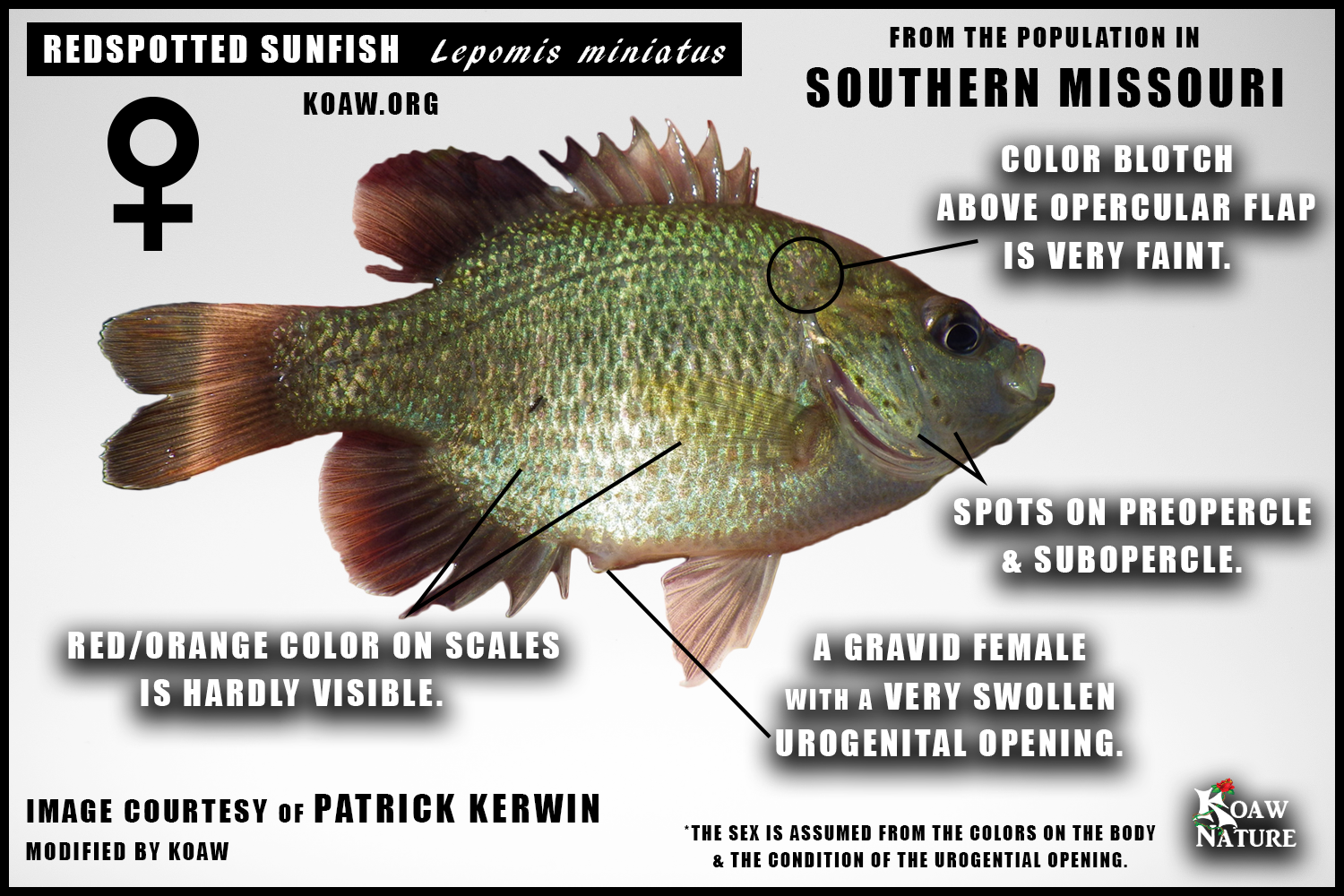By Koaw - November, 2020
GENERAL: The redspotted sunfish (Lepomis miniatus – Jordan, 1877) was once listed as a valid subspecies of the spotted sunfish (Lepomis punctatus) as L. punctatus miniatus. [1] Substantial evidence provides morphometric, meristic and genetic comparisons to clearly distinguish the two very closely related species. [2] Introgressed specimens exist in the areas where the two species have populations with past (and current) overlapping ranges, of which, makes species-level identifications much trickier if not impractical. (See “LOCATION” below for discussion on overlapping ranges with L. punctatus; see “SIMILAR SPECIES” below to view the side-by-side comparison of these species.)
The best features for an identification are examining for the presence or absence of red spots and black spots along the body, a bit of iridescent blue in the bottom of the eye, red/orange rays in the median fins, red/orange color edging around the opercular flap and comparing the location of capture to the known population map.
BODY: Like all the lepomids, the body is deep and compressed, resembling a disc. The lateral line is complete with usually 35-41 lateral scales (33-42). [2] [3]
COLORATION: The redspotted sunfish gets its name from the apparent reddish/orange spots and color blotches on the scales of the body that are more apparent below the lateral line and are more pronounced on males, especially breeding males. These red/orange colors are larger and more vivid around the pectoral fin, fading in size and color posteriorly along the body. On females the spots/blotches on the scales are less apparent and often more yellow to brown rather than red or orange, sometimes hardly visible. A darker complexion is common on many specimens, especially on breeding males where the dark body really contrasts the brighter red spots and markings. On breeding males, often a redder and more orange breast and belly is presented compared to a paler, more cream-to-yellow color seen on females and nonbreeding males. The rest of the body on nonbreeding individuals is often an olivaceous color that is darker dorsally with scales having a bluish to red/purple sheen.
Click to enlarge.
In most populations a reddish orange blotch is apparent above and often in front of the opercular flap (see the adjacent photo) and is very apparent with pronounced colors on males in breeding colors. This blotch may only be atop 3 or 4 scales, though often more. If present on females, this blotch seems limited to being very faint and more orange or pink rather than red but distinctly discernable from the colors of the nearby scales. (This blotch also exists on the spotted sunfish (L. punctatus) to a lesser degree, expressing more of a yellowish, pinkish or yellowish-orange color.)
Click to enlarge.
The rays in the median fins have an orange/red color, more pronounced distally (away from the body) as the membranes between the rays are often a mix of dusky to red to clear. The median fins tend to have a thin pink, cream, silver or white margin. [2]
Similar to the closely related spotted sunfish, the redspotted sunfish has an iridescent blue/turquoise ‘bowl’ in the lower part of the eye and less noticeably in the dorsal part of the eye. This feature is unique to the spotted and redspotted sunfishes among all the lepomids. It does seem that this iridescent area in the eye is far more apparent and vivid within the spotted sunfish (L. punctatus) compared to the redspotted sunfish.
The redspotted sunfish usually has little-to-no black spots on the body, though often maintains a small number of black spot-like markings on the head, specifically where the preopercle and subopercle often have a number of dark diffuse spots while the rest of the operculum and cheek have minimal-to-no spotting. In comparison, the spotted sunfish (L. punctatus) tends to have smaller, more roundly and darker black spots on the head in greater number as is the case along the body.
SIZE: Typically not exceeding 20 cm (8 in) in total length, [3] where 7-8 cm is a common standard length to encounter.[2]
OPERCULAR FLAP: The opercular flap or “ear flap” is often edged with a dark reddish color dorsally with a more golden red ventrally where these colors are more vivid on breeding males. In nonbreeding males and females, these colors may simply appear more whitish with no apparent red, gold or orange color. The back edge of the opercular flap is often without any apparent color but at times does have some color.
Young specimens will not have as well-developed colors on the opercular edging.
GILL RAKERS: The gill rakers along the 1st gill arch are fairly long and thin. These are seen by lifting the gill cover and looking at the white portion above the red filaments on the gill arch closest to the gill cover.
The rakers on the spotted sunfish (L. punctatus) are typically longer than those of the redspotted sunfish (L. miniatus) where the longest raker typically is greater than 3.3 times longer than wide, whereas on the redspotted sunfish, the longest raker is typically only 2.5 – 3.5 times longer than wide. [2]
I made a video describing how to locate and find these rakers that is hosted on Koaw Nature’s Fishing Smarts YouTube channel.
MOUTH SIZE: The mouth is moderately-sized where the jaw usually extends in an alignment between the anterior edge of the eye and the anterior edge of the pupil.
More specifically, the maxilla’s posterior edge will align posteriorly to the anterior edge of the orbit and anteriorly to the anterior edge of the pupil.
The mouth is larger than that of a bluegill (Lepomis macrochirus) and smaller than that of a green sunfish (Lepomis cyanellus).
PECTORAL FIN: The pectoral fin is fairly short and roundly. If bent forward, the pectoral fin will usually not exceed the anterior edge of the pupil.
Typically there are 13-14 pectoral rays. [3] [2]
HABITAT: The redspotted sunfish can be found in swamps, ponds, lakes, creeks and small to moderately-sized rivers. Usually associated with vegetation as well as muddy and sandy benthic. [3]
CLICK TO ENLARGE - This distribution map is an illustrated approximation created by Koaw primarily pulling data and information from USGS-NAS, Research Grade observations from iNaturalist and Page & Burr’s Field Guide to Freshwater Fishes.
LOCATION: The redspotted sunfish is present only in the United States and not common in the northern parts of its range. Scarce populations do exist in the northern parts of the Upper Mississippi River Basin along the Illinois River; the Illinois Endangered Species Protection Board lists this species as “threatened.” [4] Scarce populations also exist in the western parts of the Ohio River Basin in Indiana and Illinois.
This species is more commonly encountered in the southeastern Arkansas-White-Red Basin, Lower Mississippi River Basin, Texas Gulf Coast Basin and the western parts of the South Atlantic-Gulf Basin. Also present in the Tennessee River Basin. [5] [6] Likely introduced into parts of north-central Tennessee and south-central Kentucky in the Cumberland River Basin via anthropogenic means. [7]
CLICK TO ENLARGE - This distribution map is an illustrated approximation created by Koaw primarily pulling data and information from Warren 1991, USGS-NAS, Research Grade observations from iNaturalist and Page & Burr’s Field Guide to Freshwater Fishes.
CONTACT ZONE: The redspotted sunfish (L. miniatus) and spotted sunfish (L. punctatus) have overlapping ranges within the Florida panhandle from the Apalachicola Bay watershed westerly to Perdido Bay. Furthermore, introgressed specimens (or possibly semi-isolated, independently evolved populations) are encountered in Alabama in the Mobile River Basin and the northwestern parts of Georgia within the southern parts of the Tennessee River Basin. Within the approximated contact zone, specimens of the two species show traits with greater intermediacy than those specimens at the far westerly and easterly portions of their respective ranges. [2] Attempting to identify certain specimens to the species-level in the contact zone may not be possible.
Basically, with the possibilities of F1 hybridizations and ancient hybridizations that have led to introgressed populations as well as populations that may have independently evolved in semi-isolation, not to mention random introductions from anthropogenic means, it all becomes a rather confusing, yet beautiful, example of the complexities of evolution and the difficulties that arise when attempting to simply identify species.
FISHING: This is a rather small species of sunfish. Start with a size 12 (10-14) hook and cut worms or synthetic larvae mimics; I prefer to always give my baits action rather than use sit-in-place rigs. Small spinnerbaits, crankbaits and soft plastics will also attract hits.
Each of the specimens I hooked for this Lepomis survey were not visible until hitting the bait. Sight fishing really wasn’t an option even though each specimen I captured for this project came from clear water. I pulled a large male from a lake’s shoreline that was hiding underneath of a fallen tree in shallow water. I also caught specimens from a very small pocket of a pond outlet that were hiding in the dense vegetation close to the bank.
SIMILAR SPECIES:
REFERENCES:
W. N. Eschmeyer and J. D. Fong, "Species by Family/Subfamily in the Catalog of Fishes," 2016.
M. L. Warren, Jr., "Variation of the Spotted Sunfish, Lepomis punctatus Complex (Centrarehidae): Meristies, Morphometries, Pigmentation and Species Limits," Bull. Alabama Mus. Nat. Hist., vol. 12, pp. 1-47, 1991.
L. M. Page and B. M. Burr, Peterson Field Guide to Freshwater Fishes, Houghton Mifflin Harcourt Publishing Company, 2011, pp. 506-507.
Illinois Endangered Species Protection Board, "CHECKLIST OF ILLINOIS ENDANGERED AND THREATENED ANIMALS AND PLANTS," 2020.
USGS-NAS, "USGS-NAS Lepomis miniatus Range Map," [Online]. Available: https://nas.er.usgs.gov/queries/SpeciesAnimatedMap.aspx?SpeciesID=391. [Accessed October 2020].
iNaturalist, "Lepomis miniatus REDSPOTTED SUNFISH," 2020. [Online]. Available: https://www.inaturalist.org/taxa/104255-Lepomis-miniatus. [Accessed October 2020].
J. C. Wellemeyer, C. R. Harty and J. S. Perkin, "Occurrence of Lepomis miniatus (Redspotted Sunfish) in the Cumberland River Basin of Tennessee," Southeastern Naturalist Notes, vol. 15, no. 3, pp. N33-36, 2016.



